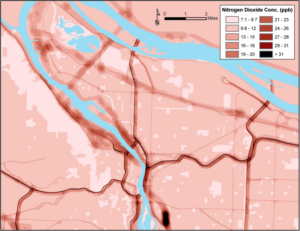One Air Sciences’ team member’s graduate research at Portland State University (Oregon) clocked a lot of time with a tabletop ultraviolet (UV)-visible spectrometer. This equipment measures how much a chemical substance absorbs light. You see, Matt had painstakingly prepared hundreds of passive air pollution monitoring devices to conduct high-density measurements of nitrogen dioxide (NO2) in east Portland. To “extract” the adsorbed NO2 from the devices, an aqueous solution was prepared with spectral properties that changed with the amount of NO2 present. Perfect, tedious work for a grad student, but it ultimately produced some gratifying results.

A land-use regression (LUR) model based on high-density NO2 measurements made in Portland, OR over several weeks. A soon-to-be-launched spaced-based spectrometer will provide hourly measurements of NO2, trading the high spatial resolution for high temporal resolution. Source: Mavko, et al. 2008.
Oh, how times have changed. Soon an instrument will be measuring NO2 every (daylight) hour, every day, over the entire continental United States. From spaaaaaace.
The Tropospheric Emissions: Monitoring of Pollution (TEMPO) mission is due for launch in 2022. This space-borne instrument uses the same basic concept as the humble laboratory spectrometer to report spectra at a sub-urban scale, and will join similar missions covering Europe and Asia. Like most Earth-observing remote sensing platforms, the TEMPO spectrometer relies on sunlight reflected from Earth’s surface and atmosphere, it will only produce data during daylight hours. It achieves its high temporal resolution by being in a geostationary orbit: with its orbit synchronized with that of the Earth’s, the bird’s eye view remains constant.
This type of monitoring will provide an unprecedented view of certain types of air pollution (especially urban pollution).
Air Sciences has participated in two TEMPO Science Team meetings since 2018 (all presentations are here) to provide input on additional types of data products and applications from the instrument. Of particular interest is TEMPO’s immense potential to improve estimates of fire emissions, fire plume behavior, and even fire detection. We are grateful we could participate in shaping the mission!
